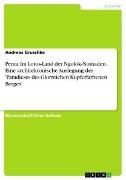Wissenschaftlicher Aufsatz aus dem Jahr 2001 im Fachbereich Orientalistik / Sinologie - Sonstiges, , Veranstaltung: Publikation, Sprache: Deutsch, Abstract: Auf gängigen kulturhistorischen Karten des tibetischen Hochlandes zeichnet sich der Lebensraum der Ngolok-Nomaden meist durch große weiße Flecken aus. Der Hauptgrund dafür dürfte sein, daß es in der westlichen Literatur kaum Beschreibungen dieser Region gibt, denn es scheiterte annähernd jeder Versuch europäischer oder amerikanischer Forschungsreisender, für längere Zeit in den Lebensraum der Ngolok-Seta, also die Großregion um die heiligen Berge Amnye Machen und Nyenpo Yutse vorzustoßen. Einige dieser Forschungsreisenden bezahlten ihre Versuche gar mit dem Leben, wie die Franzosen Dutreuil de Rhins oder Victor Liotard: "The Ngolo-Setas tribesmen belonged to that Tibet which few Europeans had penetrated, the Tibet of the primitive herdsmen of the high plateaux far removed from the civilization of Lhasa and of the settlements of the valleys." Die Vorstellungen von den primitiven, also rauhen, räuberischen und mordlustigen Ngolok blieb uns noch bis weit ins 20. Jahrhundert bewahrt. Wohl daher gab es wenig Anlaß, sich mit der Möglichkeit einer ausgeprägten Klosterkultur in jener Region auseinanderzusetzen, zumal ja selbst das berühmteste Kloster im Ngolok-Gebiet, das große Rakya Gompa am Gelben Fluß, teilweise unter deren Übergriffen zu leiden hatte: "I called on the local Buddha, of course. Without the aid of these holy men, no intruder from the outside world could last long among these fanatics. ... The Rimong chief, most powerful of the Ngoloks, would probably rob and murder us,predicted the steward. Only recently this wild tribe had even robbed a LivingBuddha, ... as his party went over one of the Ngolok trails. / ... the Buddha finally changed his mind and said he would send my messages to the Ngolokchiefs, advising them of my approach. At first, every man who was asked to goas a messenger with our letters declined the job. / ... the chief Buddha, he was powerless. The guilty clan paid not the slightest attention to him; in fact, a few nights later, they stole some of his own horses and sheep. ... News had just reached him that a member of his lamasery, returning from the Ngoloks, had been robbed and killed." Aus diesem Grunde verwundert es auch nicht weiter, daß in tibetischen Geographien, die ja im wesentlichen Beschreibungen von Tempeln, Klöstern und Pilgerorten in der tibetischen Ökumene sind, Darstellungen solcher religiöser Stätten im Kerngebiet der Ngolok selbst in tibetischen Quellen nur wenig zu finden sind. [...]


